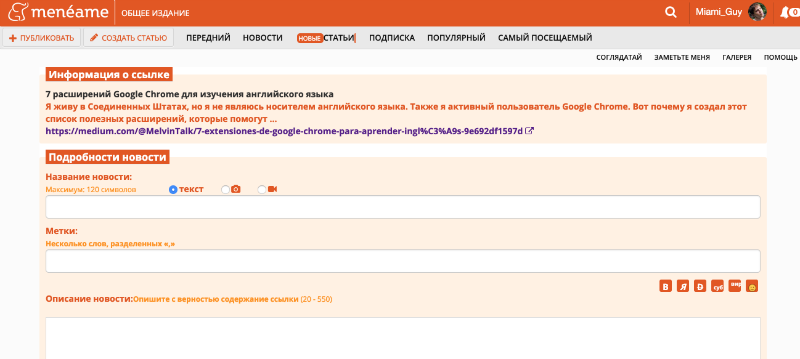Personal experience: how we were engaged in the Spanish-speaking startup promotion in Latin America

I am professionally engaged in marketing, and over the past few months I have been helping a new startup - a service for correcting errors in English texts. In the course of our work, we and his team decided to experiment with the target audience - in particular, try to get feedback from native Spanish speakers.
We did not have a marketing budget in Latin America, so we decided to use content marketing. However, it turned out that there are very few sensible materials on how and where to promote your company in Spanish. I had to figure everything out on my own, and as a result of the experiments I want to share my experience.
')
Step # 1: Collect Information
We did not know anything about the device of the Spanish-speaking segment of the Internet, so first we had to study it at least basicly. There are no Spanish speakers in the team, so there was no place to get any insider information, the data were collected in Russian and, mainly, in English.
We assumed that Spanish-speaking users should have their own counterparts of popular sites for publishing content. For example, Reddit. Various search queries and case studies on sites like Quora didn’t provide very much information - we found the popular Taringa site, and that’s it.
I had to order a consultation from an SMM specialist of a Spanish speaker at Upwork. After that, things got better.
Step # 2: Publish Content
We had a number of interesting English-language materials in the "partisan" format, it was not difficult to translate them. A much more interesting question is where to publish these texts.
We studied various blogging platforms and decided not to complicate the situation and publish content on Medium. This option had several advantages - the platform is easy to use, it has a familiar interface, you can publish content on the site in local languages (even in Russian there are a number of interesting blogs), there is statistics on each article that includes information about the source of transitions to it - this was supposed to help us in planning further work.
Step # 3: Promotion
For the "seeding" of content, we selected two main resources:
- Taringa.net is a popular site aggregator in Latin America, something like Reddit, with more than 21 million visitors.
- Meneame.net - 9.5 million visitors.
In the original table there were more sites, however, a significant part of them turned out to be too small and did not give any traffic at all, gradually we refused to repost there even in the “up to the heap” mode.
Each of them can publish links and articles, there are no particular difficulties. Some resources, like Meneame, impose additional restrictions - for example, before publishing your post, you need to make 7-8 likes to posts of other users.
Thanks to the auto-translation function in Google Chrome, publishing the content itself also poses no difficulties:

Our task was to get feedback on the product, so it was important to expand the geography of the potential audience. Here, oddly enough, Reddit came to the rescue.
It turned out that on this platform there are subsections devoted to different countries - and the content in them is published in local languages. We were lucky, and the topic of our project was well suited for publication in such subreddits - the tool is useful for learning English, it is interesting to many Spanish-speaking users.
As a result, we placed the content in these subreddits:
- r / aprendeingles / - section dedicated to the study of English;
- / r / es / - general Spanish-speaking subreddit, 14.3 thousand users;
- / r / argentina / - 92 thousand subscribers;
- / r / vzla / - section of Venezuela, 34.5 thousand subscribers;
- / r / Colombia / - 13.8 thousand subscribers;
- / r / chile / - 48 thousand users.
What is the result
In total, during the month we published 4 materials - they were read by several thousand people, we received a good conversion in registration. Hispanic audience is quite active in using the service and acquiring premium access. Moreover, the project was noticed by Latin American journalists and bloggers. In particular, after a review of what's a popular Argentine IT resource wwhat's New, several thousand people visited us in a couple of days.
A typical distribution of traffic to articles looks like this:

Sites aggregators like Meneame and Taringa show good performance, there is a live audience on Reddit. It is clearly not worth expecting that the material will be advanced by Medium algorithms on the platform itself - our initial hypothesis was confirmed.
Conclusion
Of course, such content marketing is not a tool for attracting large volumes of traffic, but if you want to test new markets with zero budget, the combination Medium + aggregators + Reddit turns out to be quite working.
Source: https://habr.com/ru/post/444548/
All Articles